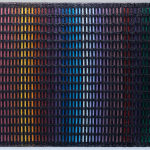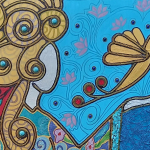
A volte i percorsi esistenziali inducono le persone a rinunciare, più o meno volutamente, alla naturale inclinazione che condurrebbe verso strade completamente differenti; altrettanto frequentemente però, è esattamente quella rinuncia, quel covare dentro di sé la tendenza a sospirare per il sogno riposto in un angolo, che induce a meditare su se stessi, sulle proprie emozioni più profonde, ad assorbire tutte le sensazioni ricevute dalle circostanze che si susseguono per immagazzinarle all’interno di sé. Solo al termine di quella fase evolutiva della propria interiorità quell’istinto lasciato in disparte torna a farsi sentire in maniera forte e incisiva al punto di non poter essere più inascoltato. Questo accade spesso con l’inclinazione artistica ed è esattamente quanto ha contraddistinto la vita di Michela Grassi che inizia a studiare arte presso lo studio triestino della pittrice Luciana Tiepolo, a sua volta allieva di Guttuso per poi, a seguito di scelte professionali e di vita, si allontana dalla creatività per concentrarsi su altre priorità; tuttavia qualche anno fa la spinta a riprendere in mano i pennelli si è fatta via via più incalzante fino a renderle impossibile non cedere di nuovo all’impulso creativo che si è manifestato in maniera più matura rispetto al passato, più completo perché affine a un’evoluzione interiore attraverso la quale ha potuto percepire ogni evento, ogni emozione, ogni punto di osservazione in maniera più equilibrata e contemplativa. Le nuove tele costituiscono dunque un punto di arrivo tra la tecnica appresa molti anni fa e uno stile espressivo in cui manifestare l’approccio alla vita che la contraddistingue, morbido, delicato perché in grado di lasciarsi andare a quel mondo interiore trattenuto all’interno di una razionalità e un pragmatismo necessari per la parte più pratica dell’esistenza. Tra i suoi soggetti preferiti vi sono infatti i fiori, in particolar modo le ortensie che infondono un senso di sofficità in virtù della loro forma a semisfera, le une vicine alle altre come se volessero costituire un cuscino colorato in cui l’essere umano si senta inviato ad adagiarsi lasciandosi cullare dalla loro positività;
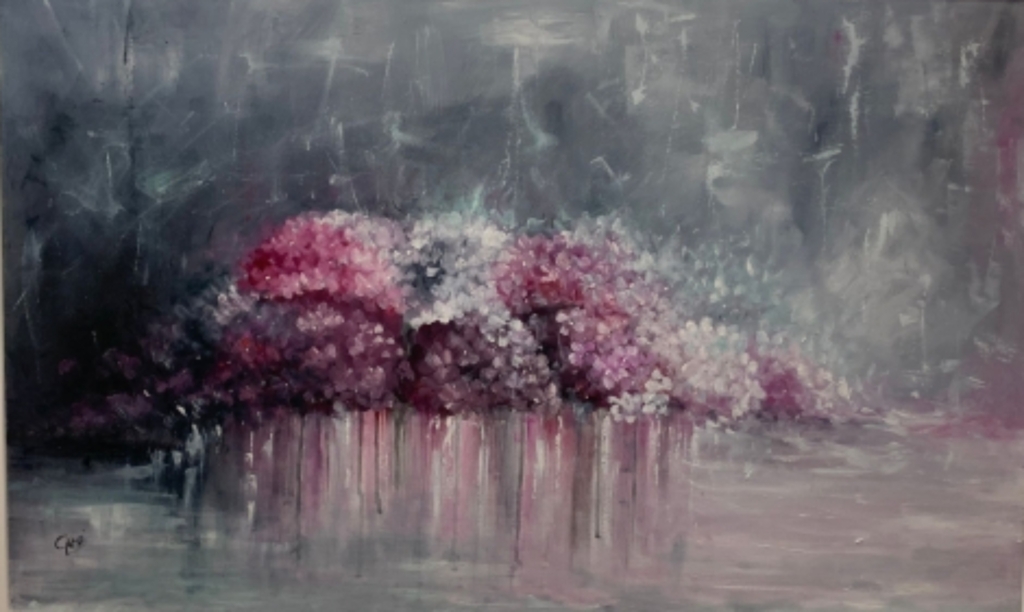
le tele dedicate a questi fiori presentano quasi sempre uno sfondo decontestualizzante, tendendo pertanto verso la Metafisica perché tutto ciò che conta per Michela Grassi è l’energia leggera ma avvolgente che deve essere prevalente su tutto il contesto circostante. Si nasconde in questa serie di opere un invito dell’artista a ritrovare il contatto con la natura capace di infondere serenità e tranquillità a un mondo interiore troppo spesso distratto dalla contingenza. Il medesimo sguardo empatico e contemplativo viene riservato anche agli altri soggetti su cui si estende l’estro creativo dell’artista, come il mondo femminile, quello a cui lei appartiene e che dunque è in grado di narrare e comprendere, osservandone i risvolti che vanno oltre la superficie, al di là dell’apparenza e della faccia che la donna mostra al mondo per sembrare più forte. Le sue protagoniste si mettono a nudo, vengono immortalate in un momento con loro stesse in cui mostrano le perplessità e le fragilità che contraddistinguono un universo sensibile e incredibilmente delicato, oppure in fangenti di socialità, quelli in cui tendono a dare il meglio di sé; eppure dall’apparenza iniziale emerge una sottile linea di solidarietà che va oltre la competizione, il bisogno di primeggiare, quasi come se attraverso il proprio filtro emozionale l’artista riuscisse a far percepire all’osservatore il meglio che può fuoriuscire se solo la donna, ma anche l’essere umano in generale, fosse capace di lasciare indietro tutti gli egoismi e i protagonismi e ricordasse semplicemente di essere parte di un tutto, di una comunità da cui il singolo non può prescindere.

Nel suo stile alterna parti prettamente pittoriche ad altre più materiche dove la ruvidità della superficie diviene necessaria per evidenziare dettagli, così come spesso la foglia oro è essenziale per sottolineare l’atmosfera che avvolge i soggetti e che si unisce all’impalpabilità degli sfondi sfumati, leggeri, come se fossero bolle di evanescenza su cui si innalza la consapevolezza delle emozioni. Andiamo ora a scoprire di più di questa sensibile artista.
Michela, lei ha rinunciato per molto tempo a lasciar fluire la sua inclinazione artistica; ci racconta quanto questo sia stato consapevolmente scelto e voluto oppure quanto invece sia stato un processo subìto perché determinato da altre priorità? Secondo lei l’aver trattenuto la sua creatività può essere stato un fattore determinante per lo stile fortemente emozionale che la contraddistingue oggi?
Direi che sono stata obbligata ad abbandonare per lunghi periodi questa mia passione, il lavoro, gli studi e i figli hanno riempito freneticamente le mie giornate e il giorno, si sa, ha solamente ventiquattro ore; ma non ho alcun rimpianto per le scelte fatte. Tuttavia reprimere questa mia passione ha sicuramente aumentato il bisogno odierno di riversare sulla tela le mie emozioni. Sì perché per me dipingere è gettare sulla tela un’emozione, lo stato d’animo che sento in quei giorni in cui creo un quadro, e saperla trasmettere all’osservatore nel momento in cui guarda l’opera.

Le sue tele sono molto contemplative, quasi come se costituissero un invito all’osservatore a fermarsi e osservare in maniera più attenta la realtà che lo circonda. Quanto è importante in un’epoca attuale costantemente in corsa, riuscire a prendersi del tempo per trovare il contatto con se stessi? Crede che la fragilità e la delicatezza siano un punto di debolezza oppure un valore aggiunto in grado di arricchire l’individuo?
Credo che in un momento socio-culturale difficile come quello odierno sia importante trovare del tempo per fermarsi ed entrare in comunicazione prima di tutto con noi stessi, poi potremo farlo anche con gli altri. Il periodo di restrizioni dell’epoca pandemica ha aumentato il distanziamento tra le persone e l’indifferenza, ha limitato la socializzazione e le iniziative culturali, fortunatamente vedo una grossa voglia di rinascita nelle persone ma ciò che abbiamo elaborato negativamente ha lasciato sicuramente un grosso segno all’interno di ciascuno di noi. In merito alla fragilità e la delicatezza penso possano sia costituire un punto di debolezza che arricchire, dipende dal contesto e da come vengono vissute.
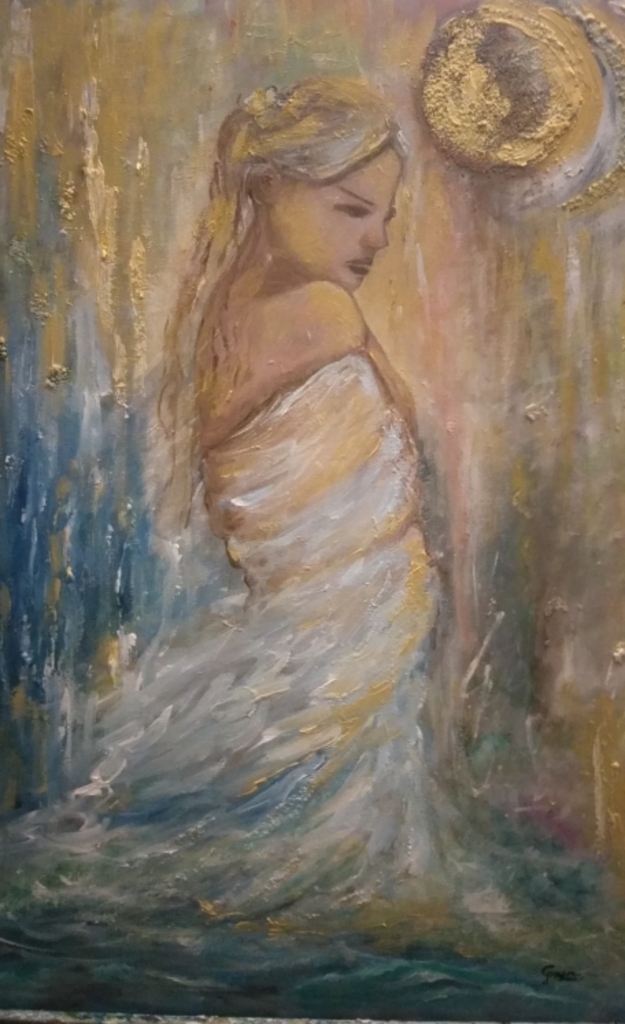
Lei ha uno stile pittorico decisamente morbido, da un lato vicino alle atmosfere più delicate e sognanti dell’Espressionismo, dall’altro si avvicina alla Metafisica mantenendo sempre costante uno sguardo romantico sulla realtà che descrive. Si è trattato di un punto di arrivo oppure la sua inclinazione l’ha portata spontaneamente verso questo tipo di approccio pittorico? Quali sono stati i grandi artisti del passato che l’hanno ispirata?
Amo le sfumature e il vedo-non vedo, i colori ed i tratti non ben definiti, anche osservando gli altri artisti mi innamoro sempre di opere che hanno queste caratteristiche, adoro chi con pochi gesti e pennellate riesce a costruire un’immagine significativa. Anche il mio modo di dipingere e la mia gestualità nel farlo sono veloci e ritmati come una danza… non sono una persona perfetta per cui non riuscirei mai ad entrare in simbiosi con il Realismo o l’Iperrealismo e ovviamente la mia passione è sempre stata per Monet e tutti gli altri impressionisti.
Agli inizi del suo percorso artistico ha esposto in località al confine tra Austria e Slovenia, in virtù della sua appartenenza a una città di confine come Trieste; quanto è stato importante confrontarsi con culture differenti e con radici artistiche di altri paesi per la sua apertura creativa? Quanto di quell’esperienza ha costituito la base per la sua maturazione espressiva successiva?
Credo che il nascere e il vivere in una città di confine in mezzo ad una commistione di lingue, generi ed etnie diverse ti porti ad avere anche degli imprinting differenti sulla tela e ti permettano di spaziare con soggetti diversi.
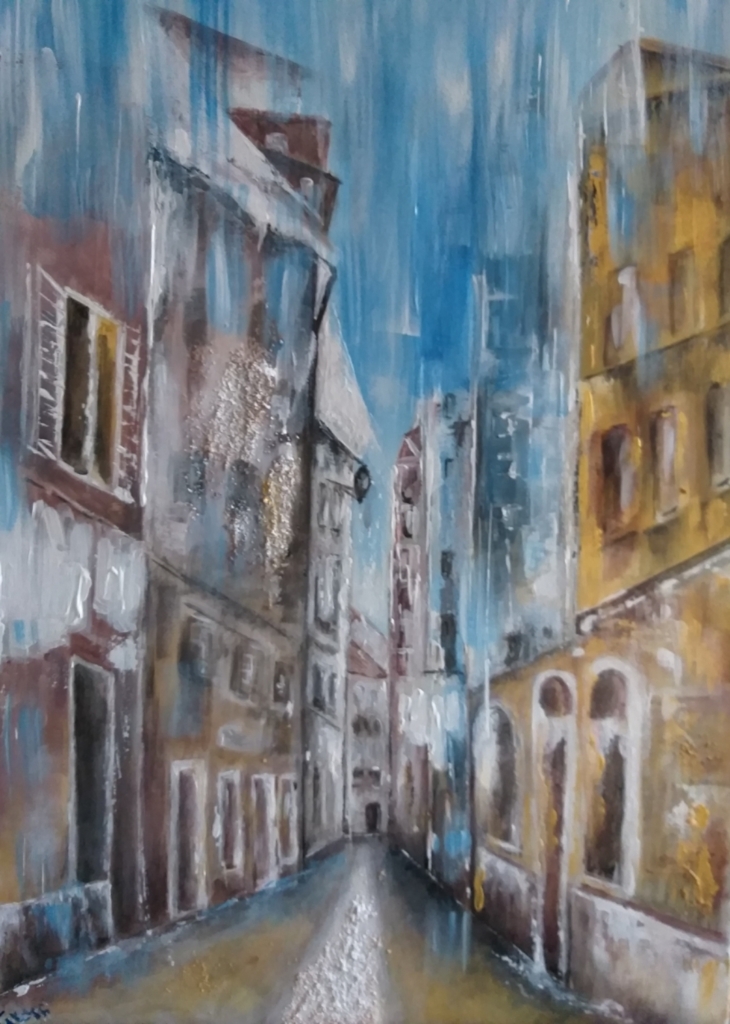
Dal momento in cui ha ritrovato il contatto con il suo istinto artistico ha ricominciato a partecipare a molte mostre collettive in Italia; ci racconta qual è stata la soddisfazione più grande e quali sono i suoi prossimi progetti? Dove potranno vedere le sue opere i nostri lettori?
Essendo la pittura un hobby, il partecipare alle mostre molte volte diventa impegnativo soprattutto economicamente, lo faccio però rinunciando ad altro perché lo ammetto ho proprio voglia di far vedere ciò che creo, ma non in maniera vanitosa, solamente per trasmettere appunto le emozioni, per potermi confrontare con i colleghi artisti ed accettare volentieri anche le critiche negative perché tutto ciò fa crescere e maturare. Una bella soddisfazione per me è stata l’esposizione con un’opera a olio su tela sulla Divina Commedia a Rocca Brivio, selezionata dal prof Giorgio Gregorio Grasso, in cui rappresentavo Dante nel contesto attuale in particolare la terzina centodiciassette dell’Inferno. Poco dopo a sorpresa ho ricevuto il primo premio della giuria nel contest Vivart organizzato dalla curatrice Antonella D’Ecclesis della Galleria Venere. E poi vedremo, al momento le mie opere sono visualizzabili su Facebook e a Trieste presso il negozio Cornitel. Il mio sogno? Lavorare su grandi formati, ne ho già fatti alcuni oltre i 120 centimetri per arredare un appartamento: è proprio sui grandi pannelli che le pennellate escono in maggior sintonia con i mie pensieri, liberatorie ed esplicative.
MICHELA GRASSI-CONTATTI
Email: michelagrassi1971@libero.it
Facebook: https://www.facebook.com/michela.grassi.94
Instagram: https://www.instagram.com/michela_grassii/
Marta Lock’s interviews: Michela Grassi, the impalpable delicacy of a creative instinct long held back
Sometimes existential paths induce people to renounce, more or less deliberately, the natural inclination that would lead them towards completely different paths; just as frequently, however, it is exactly that renunciation, that brooding within oneself of the tendency to sigh for the dream tucked away in a corner, that induces to meditate on oneself, on one’s deepest emotions, to absorb all the sensations received from the circumstances that follow one another in order to store them inside. Only at the end of that evolutionary phase of one’s interiority does that instinct left aside return to make itself felt in a strong and incisive manner to the point that it can no longer be unheard. This often happens with artistic inclination and this is exactly what has characterised Michela Grassi’s life. She began studying art at the Triestine studio of the painter Luciana Tiepolo, herself a pupil of Guttuso, and then, following professional and life choices, she turned away from creativity to focus on other priorities; however a few years ago the push to pick up the brushes again became more and more pressing to the point of making it impossible not to give in again to the creative impulse which manifested itself in a more mature way than in the past, more complete because it is similar to a inner evolution through which she was able to perceive every event, every emotion, every observation point in a more balanced and contemplative way. Her new canvases are therefore a point of arrival between the technique she learnt many years ago and an expressive style in which she manifests the approach to life that distinguishes her, soft, delicate because she is able to let go of that inner world held within a rationality and pragmatism necessary for the more practical side of existence. In fact, among her favourite subjects are flowers, particularly hydrangeas, which instil a sense of softness by virtue of their hemispherical shape, one close to the other as if to form a colourful cushion in which the human being feels sent to lie down and let himself be lulled by their positivity; the canvases dedicated to these flowers almost always present a decontextualising background, thus tending towards the Metaphysical because all that matters to Michela Grassi is the light but enveloping energy that must prevail over all the surrounding context. Concealed in this series of artworks is the artist’s invitation to rediscover contact with nature that can instil serenity and tranquillity in an inner world too often distracted by contingency. The same empathetic and contemplative gaze is also reserved for the other subjects on which the artist’s creative flair extends, such as the world of women, the one to which she belongs and which she is therefore able to narrate and understand, observing the implications that go beyond the surface, beyond the appearance and the face that women show to the world to appear stronger. Its protagonists lay themselves bare, they are immortalised in a moment with themselves in which they show the perplexities and fragilities that characterise a sensitive and incredibly delicate universe, or in social muddles, those in which they tend to be at their best; yet from their initial appearance emerges a subtle line of solidarity that goes beyond competition, the need to excel, almost as if through her emotional filter the artist managed to make the observer perceive the best that could come out if only women, but also human beings in general, were able to leave behind all selfishness and protagonism and simply remember that they are part of a whole, of a community from which the individual cannot disregard. In her style, she alternates purely pictorial parts with others that are more material, where the roughness of the surface becomes necessary to highlight details, just as gold leaf is often essential to emphasise the atmosphere that envelops the subjects and that unites with the impalpability of the blurred, light backgrounds, as if they were bubbles of evanescence on which the awareness of emotions rises. Let us now discover more about this sensitive artist.
Michela, you have for a long time renounced letting your artistic inclination flow; can you tell us how much this was consciously chosen and desired, or how much it was a process you underwent because it was determined by other priorities? In your opinion, was holding back your creativity a determining factor for the strongly emotional style that distinguishes you today?
I would say that I was forced to abandon this passion of mine for long periods of time, work, studies and children frantically filled my days and the day, as you know, has only twenty-four hours; but I have no regrets about the choices I made. However, repressing this passion of mine has certainly increased today’s need to pour my emotions onto canvas. Yes, because for me to paint is to throw an emotion onto the canvas, the state of mind I feel in those days when I create a painting, and to be able to transmit it to the observer when he looks at the artwork.
Your canvases are very contemplative, almost as if they were an invitation to the observer to stop and take a closer look at the reality around him. How important is it in today’s constantly rushing age to be able to take time to find contact with oneself? Do you believe that fragility and delicacy are a weakness or an added value that can enrich the individual?
I believe that in today’s difficult socio-cultural times, it is important to find time to stop and communicate first of all with ourselves, then we can also do so with others. The period of pandemic restrictions has increased the distance between people and indifference, it has limited socialisation and cultural initiatives, fortunately I see a great desire for rebirth in people but what we have processed negatively has certainly left a big mark within each of us. Regarding fragility and delicacy I think they can both be a weakness and an enrichment, it depends on the context and how they are experienced.
You have a decidedly soft painting style, on the one hand close to the more delicate and dreamy atmospheres of Expressionism, on the other approaching Metaphysics while always maintaining a romantic gaze on the reality you describe. Was this a point of arrival or did your inclination lead you spontaneously towards this type of pictorial approach? Which great artists of the past have inspired you?
I love nuances and see-through, colours and ill-defined strokes, even observing other artists I always fall in love with works that have these characteristics, I adore those who with just a few gestures and brush strokes manage to construct a meaningful image. My way of painting and my gestures in doing so are also fast and rhythmic like a dance… I am not a perfect person so I would never be able to enter into a symbiosis with Realism or Hyperrealism and obviously my passion has always been for Monet and all the other Impressionists.
At the beginning of your artistic career, you exhibited in locations on the border between Austria and Slovenia, due to your belonging to a border town like Trieste; how important was it for your creative openness to be confronted with different cultures and artistic roots in other countries? How much of that experience formed the basis for your subsequent expressive maturation?
I believe that being born and living in a border city in the midst of a mixture of different languages, genres and ethnicities also leads you to have different imprints on the canvas and allows you to range over different subjects.
From the moment you got back in touch with your artistic instinct, you started to participate in many group exhibitions in Italy again; can you tell us what was the greatest satisfaction and what are your next projects? Where can our readers see your works?
Since painting is a hobby, taking part in exhibitions often becomes challenging, especially financially, but I do it without doing anything else because I admit that I really want to show what I create, but not in a vain way, just to convey my emotions, to be able to compare myself with fellow artists and to gladly accept negative criticism, because this helps me grow and mature. A great satisfaction for me was the exhibition with an oil-on-canvas work on the Divine Comedy at Rocca Brivio, selected by Prof. Giorgio Gregorio Grasso, in which I represented Dante in the current context, in particular the hundred and seventeen triplet of the Inferno. Shortly afterwards I surprisingly received the first prize from the jury in the Vivart contest organised by curator Antonella D’Ecclesis of Galleria Venere. And then we will see, at the moment my artworks can be viewed on Facebook and in Trieste at the Cornitel shop. My dream? Working on large formats, I have already done some over 120 centimetres to furnish a flat: it is precisely on large panels that the brushstrokes come out in greater harmony with my thoughts, liberating and explanatory.

